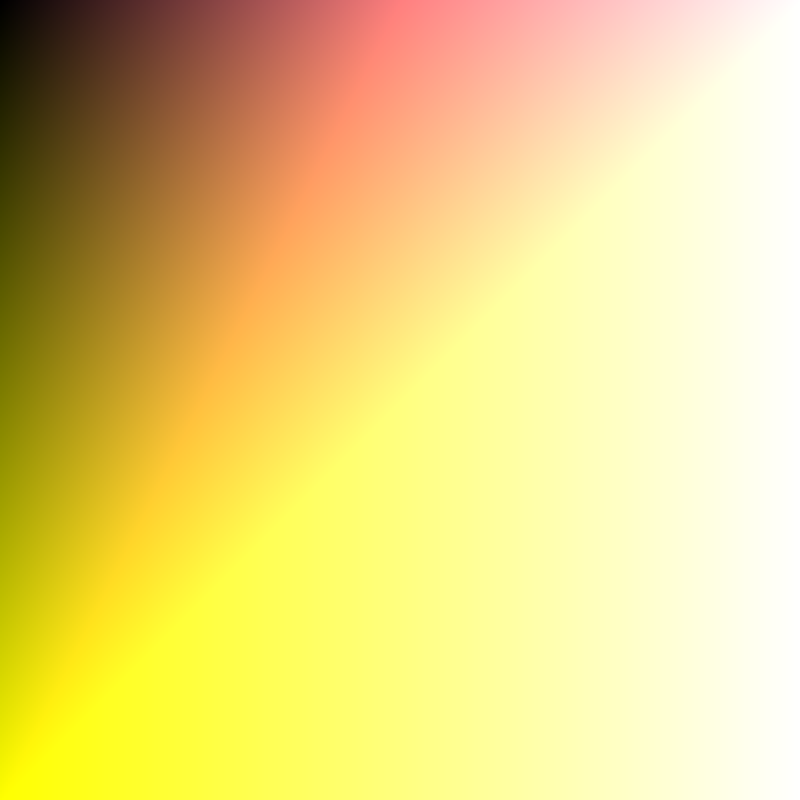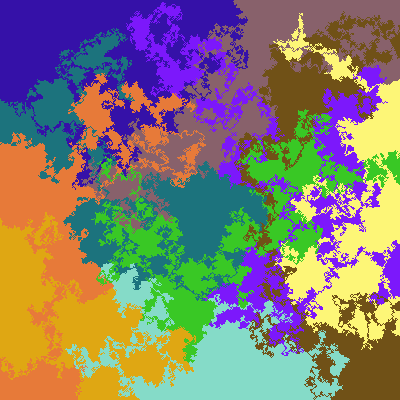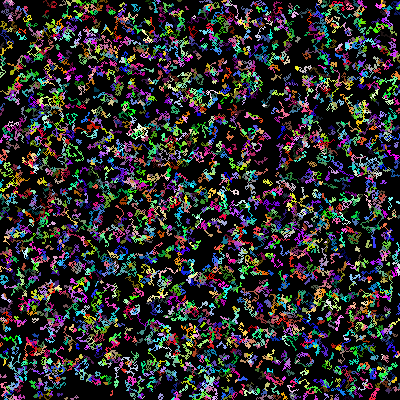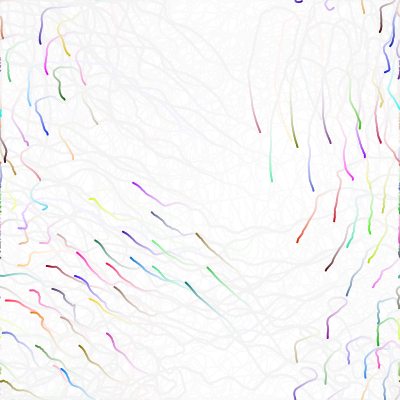Now that I’ve got register machines working, one of the next ideas I had was to implement different wrapping modes. Currently, as it stands, X and Y are passed into the machine as floating point numbers from [0, 1] across the image and output is expected to be [0, 1] for each of R, G, and B. Any values that end up outside of that range, we truncate down to that range. But some of our mathematical functions (multiplication, exponentiation, negation, etc) tend to generate numbers way out of this range. But they don’t have to!
JP's Blog
Programming, Topic: Procedural Content
All posts
- 2026-01-05: Genuary 2026.05: Write 'genuary'
- 2026-01-04: Genuary 2026.04: lowres
- 2026-01-03: Genuary 2026.03: Fibonacci forever
- 2026-01-02: Genuary 2026.02: Twelve principles of animation
- 2026-01-01: Genuary 2026.01: One color, one shape
- 2023-03-03: Genuary 2023.31: Break a previous image
- 2023-03-02: Genuary 2023.30: Minimalism
- 2023-03-01: Genuary 2023.29: Maximalism
- 2023-02-28: Genuary 2023.28: Generative poetry
- 2023-02-27: Genuary 2023.27: In the style of Hilma Af Klint
- 2023-02-26: Genuary 2023.26: My kid could have made that
- 2023-02-25: Genuary 2023.25: Yayoi Kusama
- 2023-02-24: Genuary 2023.24: Textile
- 2023-02-23: Genuary 2023.23: Moiré
- 2023-02-22: Genuary 2023.22: Shadows
- 2023-02-21: Genuary 2023.21: Persian Carpet
- 2023-02-20: Genuary 2023.20: Art Deco
- 2023-02-19: Genuary 2023.19: Black and white
- 2023-02-18: Genuary 2023.18: Definitely not a grid
- 2023-02-17: Genuary 2023.17: A grid inside a grid inside a grid
- 2023-02-16: Genuary 2023.16: Reflections of a Reflection
- 2023-02-15: Genuary 2023.15: Sine Waves
- 2023-02-14: Genuary 2023.14: Asemic Writing
- 2023-02-13: Genuary 2023.13: Something you've always wanted to learn
- 2023-02-12: Genuary 2023.12: Tessellation
- 2023-02-11: Genuary 2023.11: Suprematism
- 2023-02-10: Genuary 2023.10: Generative Music
- 2023-02-09: Genuary 2023.09: Plants
- 2023-02-08: Genuary 2023.08: Signed Distance Functions
- 2023-02-07: Genuary 2023.07: Sample a color palette
- 2023-02-06: Genuary 2023.06: Steal like an artist
- 2023-02-05: Genuary 2023.05: Debug view
- 2023-02-04: Genuary 2023.04: Intersections
- 2023-02-03: Genuary 2023.03: Glitch art
- 2023-02-02: Genuary 2023.02: Made in 10 minutes
- 2023-02-01: Genuary 2023.01: Perfect loop
- 2022-08-29: Runelang: A Summoning Circle Generator
- 2022-08-25: Runelang: A Bind Rune Generator
- 2022-07-16: Runelang: Evaluation
- 2022-03-18: Runelang: The Parser (Part 2: Expressions)
- 2022-03-15: Runelang: The Parser (Part 1)
- 2022-02-24: Runelang: The Lexer
- 2022-02-23: Runelang: Language Specification
- 2021-09-06: Neural Network Cellular Automata
- 2021-03-24: A quick ruby DSL for creating L-Systems
- 2021-01-26: A DSL for rendering magic circles and runes
- 2021-01-08: Genuary: Triple Nested Loops
- 2020-12-11: Pictogenesis: Stack Transpiling
- 2020-12-09: Pictogenesis: Stack Machine
- 2020-12-03: Pictogenesis: Transpiling
- 2020-12-01: Pictogenesis: Wrapping Modes
- 2020-11-24: Pictogenesis: Register Machine
- 2020-11-23: Pictogenesis: The Idea
- 2020-11-20: Backtracking Worm Coral
- 2020-11-19: Worm Coral
- 2020-11-18: p5js Boids
- 2020-11-17: p5js Worms
- 2017-12-21: AoC 2017 Day 21: Fractal Expander
- 2016-12-17: AoC 2016 Day 17: Md5 Maze
- 2016-12-16: AoC 2016 Day 16: Dragon Data
- 2016-12-13: AoC 2016 Day 13: Noisy Puzzle
- 2015-01-09: Let it snow!
- 2014-09-17: Invader Fractals
- 2014-09-16: Fractal Invaders
- 2014-09-14: Procedural Invaders
- 2014-08-07: Langton's ant
- 2014-03-11: Brownian trees
- 2013-11-30: Twitter puddle
Recent posts
Pictogenesis: Register Machine
Okay. First Pictogeneis machine: a register based machine. Today we’re going to create a very small language with a small number of registers that can read from the outside world, write colors, and act as temporary variables.
Something like this:
gt? t0 b y x r
add g y x
abs b x
inv t0 g
add r g x
sub t0 b r
mul x r b
abs y x

In each case, the first argument is the output and the rest are inputs. So:
# gt? t0 b y x r
if (b > y) {
t0 = x;
} else {
t0 = r;
}
# add g y x
g = y + x
# abs b x
b = |x|
...
Where x and y are the input point x and y mapped to the range [0, 1]; r, g, b are the output colors in the same range and t{n} are temporary registers just used during the program.
Pictogenesis: The Idea
PICTOGENESIS REBORN!
I don’t know if I ever actually posted it publically, but one of the ideas I’ve had percolating for the longest time is combining tiny interpreters and genetic algorithms to make generative art.
The basic idea is to generate programs (in various styles) that can take x,y coordinates and return colors. Then apply that to every pixel on an image to make generative art. Once we have, figure out a way to mutate/breed the programs so that we can apply a genetic algorithm to them and make awesome images! Sort of like Electric Sheep (that brings back memories).
The evolution point of view was actually a pretty tricky problem, since programs can have a number of different representations. I could compile them to bytecode and mutate that, but how do I make most code at least potentially meaningful?
Backtracking Worm Coral
Let’s take yesterday’s Worm Coral and turn it up to 11!
Now we have:
- Whenever a worm gets stuck, it will ‘backtrack’: it will instead expand from the previous position recursively
That means that the initial 10 worms should always be able to fill the entire world! Even if one closes off an area, that one can eventually fill it up:

I like how occasionally you get one spindly bit (usually early in the run) that another goes through. It reminds me of Blokus It does take a while.
In addition, I wanted to play a bit with simulationism:
- Worms can potentially
changeColoreach frame - Every
framesPerGenerationcheck if each worm diesdeathChanceor spawns a child worm (spawnChance) - If a worm dies, it is removed from the simulation
- If a worm spawns, it creates a new child at it’s current location
- If
spawnIncludesHistoryis set, the child can backtrack into the parent’s history - If
spawnVariesColoris set, the child will (potentially, it’s random) have a slightly different color
- If
Let’s check it out!
Worm Coral
Today, I’m going to work on using worms to generate coral, similar to what I did way back when I was generating omnichromatic images.

In a nutshell:
- Spawn n worms
- On each tick:
- Each worm tries to randomly move one direction
- If it cannot, increment that worm’s
stuckcounter - If it can, restart the
stuckcounter - If a worm is
stucklong enough, kill it off and spawn a new worm
Eventually, we’ll fill the entire space with colors that end up looking a bit like coral. I’ll probably extend this later, since there are a lot of cool tweaks you can do with this general idea.
p5js Boids
Okay, sketch 2: Boids!
The basic idea is to create a bunch of particles (the Boids in this case) and apply to them each a series of simple, limited rules that rely neither on communcation between the Boids nor a global controller and see what behaviors you can generate. Specifically, can you replicate the flocking behavior found in birds, since birds can obviously fly together without hitting one another and also without some lead bird giving orders.
Something like this:

For this case, there are three rules:
- seperation - Fly away from any Boids that are too close to you (to avoid collision)
- alignment - Align yourself to fly in the same direction as any Boids in your field of vision
- cohesion - Fly towards the center point of the Boids you can see
p5js Worms
One thing that I’ve been hoping to get into a bit more is the idea of Generative Art. Essentially, use any of a wide variety of algorithms to generate art. To do that, and so that the art can be generated right in front of you in the browser, I’m going to use the p5js library. It gives you a nice API of graphical primitives and takes a simple setup and draw function and does the rest.
AoC 2017 Day 21: Fractal Expander
Source: Fractal Art
Part 1: Start with an input image made of
.and#pixels. Forniterations, break the image into blocks:
- If the current size is even, break the image into 2x2 chunks and replace each with a 3x3 chunk
- If the current size is odd, break the image into 3x3 chunks and replace each with a 4x4 chunk
The replacement rules will be specified in the following format (example is a 3x3 -> 4x4 rule):
.#./..#/### => #..#/..../..../#..#In that example, replace this:
.#. ..# ###With this:
#..# .... .... #..#Any rotation or reflection of a chunk can be used to match the input of a replacement rule.
After
n = 18iterations, how many#pixels are there?
AoC 2016 Day 17: Md5 Maze
Source: Two Steps Forward
Part 1: Create a 4x4 grid of rooms with doors
Up,Down,Left, andRight from each location. To determine if a door is currently open:
- Calculate
MD5(salt + sequence)where sequence is a string containing any combination ofUDLRdepending on how you got to this room- The first four hex values represent the doors
Up,Down,Left, andRight respectively:bcdefmeans open; anything else is closed
Find the shortest path from
(0, 0)to(3, 3).
AoC 2016 Day 16: Dragon Data
Source: Dragon Checksum
Part 1: Generate noise using a modified dragon curve:
- Start with data
a- Create a copy of the data
b, reverse and invert it (0 <-> 1)- Create the string
a0b
Repeat until you have enough data, truncate at the end if needed.
From this string calculate a checksum as follows:
- xor each pair of bits, concatenate the results
- If the resulting string has an even length, repeat; if it’s odd, stop
Calculate the checksum of a given initial state expanded to
272bits.